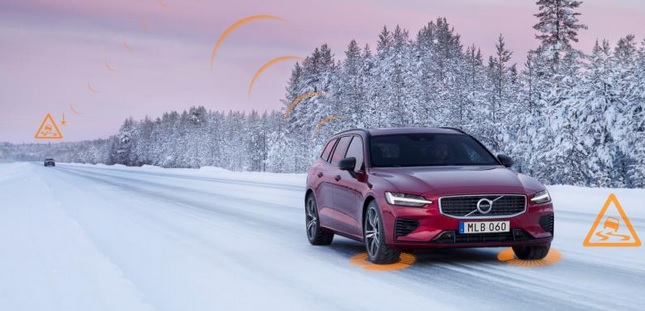Volvo cars warn each other for hazards through the cloud
Imagine a car that detects wheel spin due to slippery road conditions and sends out this information together with the gps location to a cloud platform so that other cars are warned automatically. Volvo is no longer dreaming about this – it has been offering the technology to its Norwegian and Swedish 90 Series customers since 2016.
The time has now come to expand this connected car feature to the rest of Europe and to its entire line-up. Actually, it comprises two features: Hazard Light Alert and Slippery Road Alert. They come as standard on all new model year 2020 Volvos. Interestingly, they can be retrofitted on all Volvo models based on the company’s Scalable Product Architecture (SPA) or Compact Modular Architecture (CMA) from model year 2016 and onwards. Only the first-generation 60 Series (S60, V60, XC60) and the current V40 are excluded.
If you have a current-generation V60, XC60, S90, V90, XC90 or an XC40, your car can benefit from the upgrade. It is unclear whether this upgrade is free of charge or comes at a premium.
No automatic slowing down (just yet)
Safety research by Volvo shows that adjusting speeds to the actual traffic situation can radically reduce the risk for accidents. By alerting people to dangers ahead in a timely manner and allowing them to adapt with time to spare, connected safety technologies can support better driver behaviour and boost traffic safety. This means that the car will only display a warning rather than automatically slow down.
That may very well be the case in the near future. It is Volvo’s ambition to reduce the number of people killed aboard a new Volvo to zero from 2020 onwards. That is why the brand will introduce a speed cap of 180kph on all MY2020 cars and is considering the introduction of geofencing technology combined with smart speed control to automatically limit the speed around schools and hospitals, for instance.
Only Volvo cars for now
“The more vehicles we have sharing safety data in real time, the safer our roads become. We hope to establish more collaborations with partners who share our commitment to safety,” said Malin Ekholm, head of Volvo Cars Safety Centre.
Indeed, only Volvo cars can share hazard warnings with each other today, but it is the OEM’s goal to establish partnerships with other carmakers.
Last month, the Swedish carmaker announced it is opening up its accident research database to other manufacturers, just like it did with the three-point seatbelt 60 years ago.
Authored by: Dieter Quartier
Source: https://www.fleeteurope.com
Source:  I´m a Fleet Management expert, and the manager of Advanced Fleet Management Consulting, that provides Fleet Management Consultancy Services.
I´m a Fleet Management expert, and the manager of Advanced Fleet Management Consulting, that provides Fleet Management Consultancy Services.




